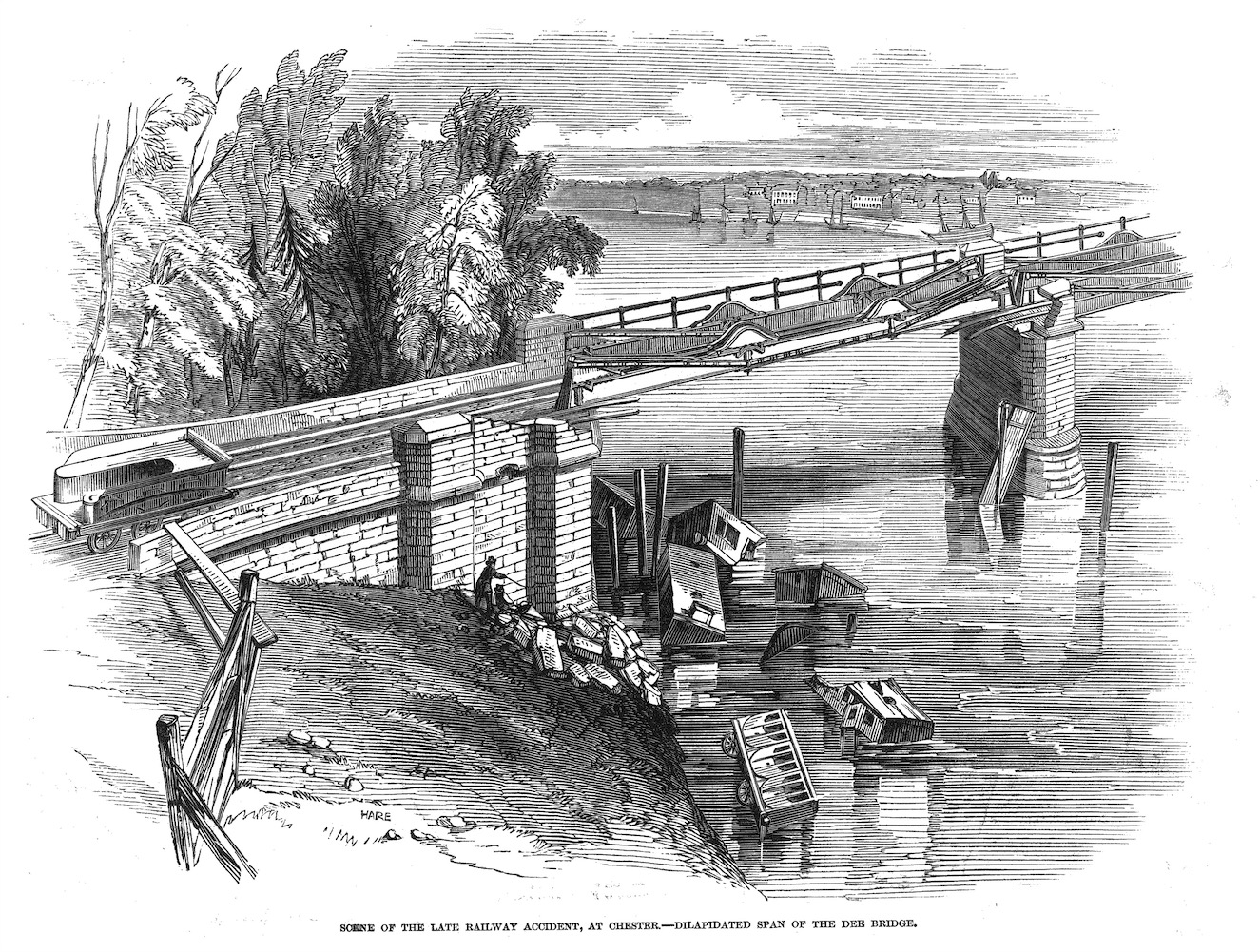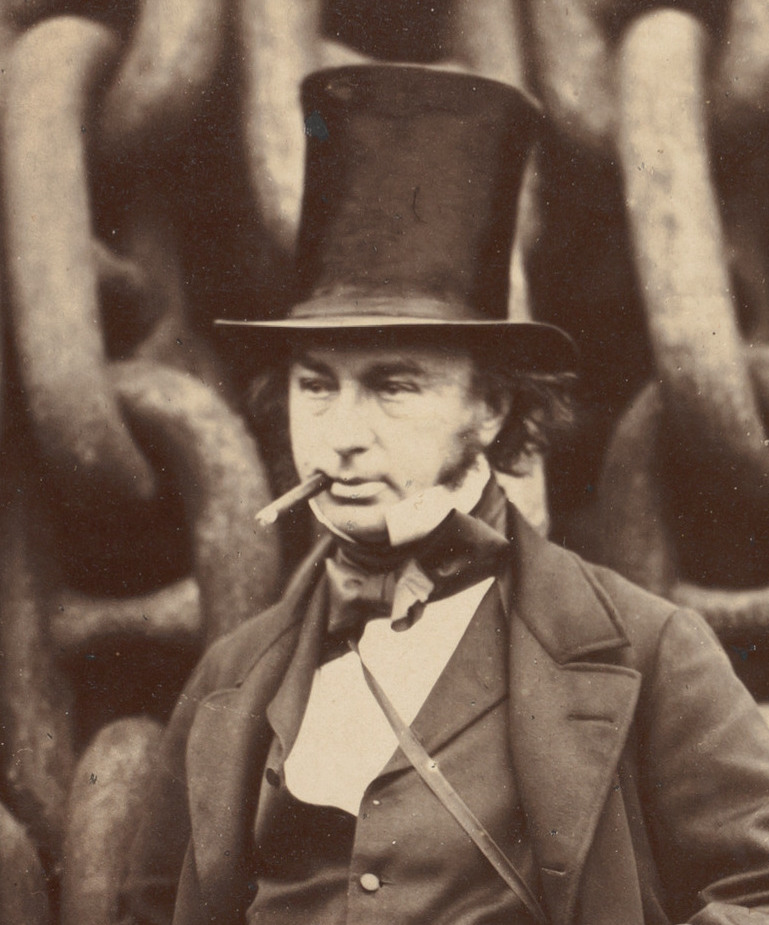On May 24, 1847, a bridge over the Dee River in Chester, England, collapsed. A passenger train plunged into the river; five people were killed and nine seriously injured.
The subsequent investigation blamed the bridge’s cast iron girders. Cast iron, like concrete but unlike wrought iron or steel, is strong in compression but weak in tension, and it is brittle, meaning that it breaks all at once, rather than deforming. The wrought iron trusses evidently were not enough to strengthen the girder.

In response to the disaster, a Royal Commission on the Application of Iron to Railway Structures was created in August of that year, “to inquire into the conditions to be observed by engineers in the application of iron in structures exposed to violent concussions and vibration”—that is, to set up standards and requirements, or as they were known in France at the time, règles de l’art.

In their investigation, the Commission solicited the opinion of one of the most eminent engineers of the age, Isambard Kingdom Brunel. But his response was, presumably, not what they expected.
Brunel begins his letter by saying that he is sorry they asked for his opinion, because of “my doubts of the advantage of such an enquiry, and my fears of its being, on the contrary, productive of much mischief, both to science and to the profession.” (Brunel’s son, writing his biography, says that he called them “The Commission for Stopping Further Improvements in Bridge Building.“) But since they did ask, he felt it necessary to state his full and honest views.
While he was happy to give his engineering opinion to the commission, he warned that
… the attempt to collect and re-issue as facts, with the stamp of authority, all that may be offered gratuitously to a Commission in the shape of evidence or opinions, to stamp with the same mark of value statements and facts, hasty opinions and well-considered and matured convictions, the good and the bad, the metal and the dross … this, I believe, always has rendered, and always will render, such collections of miscalled evidence injurious instead of advantageous to science…
He argued that there was no way the Commission could get better information than an engineer could on his own, but that in addition they would receive a lot of useless opinions, which they would feel compelled to publish anyway.
He went on to explain why he believed that rulemaking by such bodies would stop progress in the field:
If the Commission is to enquire into the conditions “to be observed,” it is to be presumed that they will give the result of their enquiries; or, in other words, that they will lay down, or at least suggest, “rules” and “conditions to be (hereafter) observed” in the construction of bridges, or, in other words, embarrass and shackle the progress of improvement tomorrow by recording and registering as law the prejudices or errors of today.
Nothing, I believe, has tended more to distinguish advantageously the profession of engineering in England and in America, nothing has conduced more to the great advance made in our profession and to our pre-eminence in the real practical application of the science, than the absence of all règles de l’art—a term which I fear is now going to be translated into English by the words “conditions to be observed.” No man, however bold or however high he may stand in his profession, can resist the benumbing effect of rules laid down by authority. Occupied as leading men are, they could not afford the time, or trouble, or responsibility of constantly fighting against them—they would be compelled to abandon all idea of improving upon them; while incompetent men might commit the grossest blunder provided they followed the rules. For, in the simplest branch of construction, rules may be followed literally without any security as to the result.
There are many opportunities for improvement in the use of iron in railway structures, he says, and “unless the Commissioners are endowed with prophetic powers, it is impossible that they can now foresee what may be the result of changes in any one of these conditions.”
For instance, while cast iron was seen at the time as “a friable, treacherous, and uncertain material,” and wrought iron “comparatively trustworthy,” he suggested that unknown developments in the future might make cast iron strong and safe, perhaps more so than wrought iron, since cast iron could be created in large homogenous pieces, whereas wrought iron had to be made in smaller pieces which were then welded together.
He continued:
What rules or “conditions to be observed” could be drawn up now that would not become, not merely worthless, but totally erroneous and misleading, under such improved circumstances? But above all, I fear—nay, I feel convinced—that any attempt to establish any rules, any publication of opinions which may create or guide public prejudice, any suggestions coming from authority, must close the door to improvement in any direction but that pointed out by the Commissioners, and must tend to lead and direct, and therefore to control and to limit, the number of the roads now open for advance.
I believe that nothing could tend more to arrest improvement than such assistance, and that any attempt to fix now, or at any given period, the conditions to be thereafter observed in the mode of construction of any specific work of art, and thus to dictate for the present and for the future the theory which is to be adopted as the correct one in any branch of engineering, is contrary to all sound philosophy, and will be productive of great mischief, in tending to check and to control the extent and direction of all improvements, and preventing that rapid advance in the useful application of science to mechanics which has resulted from the free exercise of engineering skill in this country, subjected as it ever is, under the present system, to the severe and unerring control and test of competing skill and of public opinion. Devoted as I am to my profession, I see with fear and regret that this tendency to legislate and to rule, which is the fashion of the day, is flowing in our direction.
To be clear, Brunel was not arguing for the use of cast iron in bridges. In another letter about a year later, he wrote that “Cast-iron girder bridges are always giving trouble … I never use cast iron if I can help it.” (And when it was necessary, in order to create girders larger than wrought-iron processes could produce, he insisted on a particular mixture of iron, cast in a very careful way, and he supervised the casting himself. “I won’t trust a bridge of castings run in the ordinary way.”)
The process for making sturdier, safer cast iron that Brunel speculated on never appeared. Instead, we invented new ways of making large girders out of wrought iron, and later steel, and cast iron fell out of use as a structural material. But of course, the unknowability of this outcome was exactly Brunel’s point.
(The interpretation of Brunel’s opinions, and applicability to today, are left to the reader.)
